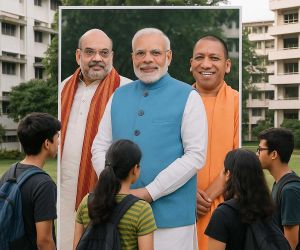MORE COVERAGE
Twitter Coverage
Satyaagrah
Written on
Satyaagrah
Written on
Satyaagrah
Written on
Satyaagrah
Written on
Satyaagrah
Written on
JOIN SATYAAGRAH SOCIAL MEDIA
Vishal Jood – a Bharatiya student targeted by Khalistanis and jailed by Australia

Vishal Jood (24), a native of Haryana who went to Australia to study, was arrested on 16 April in Sydney for his alleged involvement in three ‘suspected hate crimes’. He has been denied bail, and has been assaulted by a prison guard while in captivity according to his lawyer.
So what is the real story behind Vishal Jood’s arrest, and why has this young man been languishing in a Sydney jail for close to 2 months now?
Chasing a dream
Many from Bharat and other developing countries are lured by the dreams of a better life in developed Western countries. The racist, colonial past of these countries has been largely forgotten, and their emphasis in the 21st century is on multiculturalism and racial equality, or so we are told.
These immigrants to the West end up paying excruciating costs in terms of financial and mental stress in search of better lives. Some do well and succeed socially & economically, especially those with sought-after educational qualifications, while many struggle for a dignified existence. The one thing most of them realize is that the jobs available to them are the ones the locals don’t want. But as they’re now in the game, they play on. Many immigrants who land there as students by paying big sums for fees, end up working odd jobs like delivering food, cleaning cars etc. to make ends meet.
Originally from Haryana, Vishal is one of those thousands who moved to Australia chasing dreams of a better life. Working odd jobs to sustain himself and reportedly with an expired visa, Vishal came into the limelight when Australia’s media covered his arrest where he was accused of being part of a series of attacks, including that on a car targeting its occupants in Sydney.
Some in the Indo-Australian community believe the media there was quick to portray those attacks as ‘racist’, in an attempt to deflect attention from the far more common attacks on Bharatiya-origin students and immigrants by racists and White supremacist goons.
Back in 2009, Bharatiya student groups had organized protest marches in Melbourne and Sydney after a wave of racial assaults shook the community. Harris Park area of Sydney was highlighted as particularly unsafe – incidentally, this is the same area where the attacks that Vishal stands accused of occurred. The protesting students had claimed that Australian police and other authorities were apathetic to their plight. Some Australian media outlets had mocked the coverage those assaults received in Bharat and elsewhere as a ‘media circus’.
Pro-Khalistan elements in Sikh diaspora and the ‘farmers protest’
The 3 attacks that Vishal has been accused of occurred on 16 September 2020, and 14 and 28 February this year. All the alleged victims are believed to be Sikhs, most of them students from Bharat, except that they don’t like to be called Bharatiya or Indian. They prefer going with their religious identity, try to appropriate the Punjabi identity entirely for themselves. and support the idea of Khalistan, a separate country they want to carve out from Bharat but which surprisingly doesn’t include any part of Pakistani Punjab.
The “K” word sets alarms bells ringing in the Bharatiya mind, reviving horrible memories from the 1980s and 90s when the Khalistani terror movement ravaged Punjab and led to the loss of many innocent lives, both Hindu and Sikh.
Radicalisation amongst the Sikh diaspora in countries like UK, Canada, Australia and USA, fueled by the Pakistani establishment and ignored with a wink and nod by the West, is a well-known phenomenon. Khalistanis, both settled for long and those who escaped Bharat during the 1980s, now control a large chunk of Sikh religious places in Western countries, and its not unheard of for these places to be used to preach hatred against Bharat and Hindus. Hence it was not surprising to see Khalistani propaganda news outlets joining hands with Islamists to rejoice in Vishal’s arrest.
The same Amar Singh, who heads an organisation called ‘Turbans4Australia’, can be heard speaking to 7News Australia in a short news report on the case, where the reporter says “Sikhs believe they were targeted for their turbans”.
The tussle between the Bharatiya (Indian) diaspora and these Khalistani extremists has been bubbling under the surface for long, as this Aug 2020 video shows. However, the tensions really bubbled over once farmer protests began in Punjab in Sept last year, after passage of 3 much-needed agricultural reform laws in Bharat’s parliament. The protests are led by dominant sections of the farming community, mostly better-off Jat Sikhs, and middlemen who are upset at the status quo being disturbed.
Protests were organized in Australia too, and at one such protest last year in Quakers Hill, Sydney where Vishal and his friends went to counter the anti-Bharat, false rhetoric, he was attacked by pro-Khalistan extremists.
The protests in Bharat moved to the borders of Delhi by late November, and were soon infiltrated by all sorts of leftist malcontents and Khalistani extremists. Protest leaders took maximalist positions and refused to engage with the Government, and even snubbed the Supreme Court’s efforts to mediate.
Come 26th January & the violent, seditious events at Delhi’s Red Fort sent shockwaves across Bharat & the Bharatiya diaspora throughout the world. However, the protests were celebrated in international media headlines, and Western media was quick to make heroes out of the rabid mob of hooligans rioting in Bharat’s capital. A toolkit document inadvertently shared by celebrity activist Greta Thunberg laid bare the international Khalistani propaganda at play behind the mask of ‘farmers protest’.
Overseas Bharatiya groups quickly started gatherings in solidarity with Bharat and its tricolor, only to be attacked and intimidated by larger, more organised & violent mobs of Khalistan supporters in Canada and Australia. There were some reports of attacks on Bharatiya-owned businesses in Perth, Sydney & Melbourne. Rumors went around of a Bharatiya flag being burnt in a Gurudwara in Sydney, a Tiktok video as evidence. Soon a group of Bharatiya students in Sydney retaliated by burning a Khalistan flag and one of them posted a picture of him standing on the same Khalistan flag.
In this environment, when a Bharatiya student dared to burn a Khalistani flag, it set the entire Khalistani ecosystem on fire. It was an unforeseen insult to the extremists who, thanks to their propaganda speeches, believed ‘meek Hindus’ can never retaliate to their aggression. For them, the ideal is the terrorist cleric Jarnail Singh Bhindranwale who occupied the holy Golden Temple after massacring several innocents, and was finally flushed out and shot dead by the Indian Army in 1984.
Soon a Tiktok video went viral from a pro-Khalistan account. It showed a bunch of Khalistanis beating someone up brutally. Soon, they declared they had bashed an individual named Vishal Jood who had ‘insulted their flag’.
Only later did it come to light that they had ended up bashing some random guy, not Vishal. Soon, Vishal was seen organising a car rally in solidarity with the Bharatiya tricolour, which was set upon by aggressive Khalistani extremists.
Both these incidents of Bharatiya students being attacked by anti-Bharat fanatics were ignored by the Sydney police and no action was taken. So what happened next?
A series of back and forth Tiktok-tok videos emerged where Khalistanis abused Bharat and Hindus and dared the Bharatiya students to fight. These videos were countered by hot-headed Bharatiya students who went on to give away their address, daring the Khalistanis to attack.
On the night of 28 February, locals say a car was seen doing circles of Sydney’s Harris Park shopping strip that is called mini-India. Soon that car approached a home where a fight ensued. Apparently, driven by their frustration of not avenging the burning of the Khalistan flag, the extremists wanted to bash Vishal in the house that he was renting, only to be outmatched by the Haryana lad and his friends.
However, this time something triggered a media and police reaction. Radical, pro-Khalistani Sikh leadership approached the media saying they are being targeted by Hindus due to their turbans. Media ran their story of how ‘people opposing the farm laws in India are being attacked by Indian immigrants in Australia’. It gelled well with the narrative of ‘fascist Modi’ and ‘Hindutva extremism’ that Western media of all shades was already peddling.
And why did the police jump into action all of a sudden? A spate of violence against Bharatiya businesses; students, Bharatiya demonstrators getting threat messages from Babbar Khalsa, a banned terrorist organisation – nothing had made them move a muscle so far, but this fight suddenly called for action!
Why would that be? The answer is vote-bank politics. Sikhs constitute 2% of Bharat’s population but in Australia they form around a third of the 500,000 Bharatiya immigrant community. A religious people, they don’t fail to turn up to Gurudwaras every week. Many of these Gurudwaras happen to be controlled by Khalistani elements, who don’t miss an opportunity to invite local politicians to their Sunday feasts. When someone claiming to be the representative of such a vocal and united social group approaches a minister, action can be extracted in exchange of a promise of votes.
Locals believe this is exactly what prompted the Sydney police to keep aside other important work and focus on arresting a Bharatiya student whose only crime, if any, was acting in self-defence and allegedly burning a Khalistani flag.
Vishal was arrested at 7 AM on a Friday morning and denied bail. The Australian Police has stated that there is an outstanding warrant against him since 2018 – for what crime, they did not specify. The Indian High Commission counsellor was also not allowed to access him, it is alleged. It later emerged that he was a diabetic and didn’t have access to his medicine in jail. For days, his friends and family were denied access despite his medical condition. When the news went around, members of Australia’s Bharatiya community collected funds and arranged a lawyer for him.
Then there was news of him being assaulted by a pro-Khalistan Sikh guard in the prison. Vishal’s lawyer took it up with prison authorities, threatening legal action, which led to the police adding further criminal charges against Vishal and transferring the case to a higher court, to cause further distress to Vishal and the Bharatiya community. Knowing well that a case built on burning of a flag belonging to an imaginary country won’t hold ground in a court of law, the Sydney police are now playing the delaying game, Vishal’s friends and family believe. After all, losing to someone deemed as their former subjects, that too in their own court of law, won’t be an acceptable outcome for them.
What next?
A question remains to be asked and this should come from the Bharatiya government itself that why would a state police department in Australia decide to support a radical, religious separatist movement in Bharat? When Australia claims to treat all communities equally, why is it playing the divide and rule card to suppress one and promote another? Why has Australian law enforcement conveniently ignored violent attacks on one group of people, while cracking down on someone who merely used his freedom of expression to vent out his anger? Does this have to do with the colonial-hangover in the Anglo-Saxon world, aka Western Anglosphere, and their deep-rooted bias against ‘pagan’ Hindus? Let’s not forget that the seeds of the divide between Sikhism and Hindu Dharma, which has today manifested in the form of Khalistani separatism, were sowed by British colonials.
Vishal Jood’s story needs to reach out to the Bharatiya masses and the people need to know how he is being made to suffer by foreign authorities for showing love for his motherland. Whatever his alleged wrongdoings, he refused to cow down to threats and intimidation. Now, it is up to Australia to prove that they can give him a fair hearing, and also prosecute the religious extremists who threaten the integrity of Bharat and have been harassing and provoking peaceful Bharatiya students.
 Support Us
Support Us
Satyagraha was born from the heart of our land, with an undying aim to unveil the true essence of Bharat. It seeks to illuminate the hidden tales of our valiant freedom fighters and the rich chronicles that haven't yet sung their complete melody in the mainstream.
While platforms like NDTV and 'The Wire' effortlessly garner funds under the banner of safeguarding democracy, we at Satyagraha walk a different path. Our strength and resonance come from you. In this journey to weave a stronger Bharat, every little contribution amplifies our voice. Let's come together, contribute as you can, and champion the true spirit of our nation.
 |  |  |
| ICICI Bank of Satyaagrah | Razorpay Bank of Satyaagrah | PayPal Bank of Satyaagrah - For International Payments |
If all above doesn't work, then try the LINK below:
Please share the article on other platforms
DISCLAIMER: The author is solely responsible for the views expressed in this article. The author carries the responsibility for citing and/or licensing of images utilized within the text. The website also frequently uses non-commercial images for representational purposes only in line with the article. We are not responsible for the authenticity of such images. If some images have a copyright issue, we request the person/entity to contact us at This email address is being protected from spambots. You need JavaScript enabled to view it. and we will take the necessary actions to resolve the issue.
Related Articles
- Exclusive: Agitators not farmers but criminals, says wife of victim burnt alive at Tikri border, farmers harass woman of village, says sarpanch
- Twitter rewards an Islamist org, set to be banned by India, with a verified blue tick: Here is what PFI has done in the past
- खिलाड़ियों का धार्मिक आधार पर खालिस्तानी आतंकियों को महिमामंडित करना: खतरा कितना बड़ा है?
- ‘India Out’ Campaign which was once-receding is Gaining Traction in Maldives & It Has a Lakshadweep Link
- 10% of Punjab is now Christian! Why are people converting and what can be done?
- Aatish Taseer shows how his ‘jamaat’ has mastery over playing victim, brands Bollywood pro-Modi even as it remains anti-Hindu
- ‘Don’t use IMA to propagate any religion’: Read what the Delhi court said slamming IMA President John Rose Jayalal
- Congress leader spreads vaccine hesitancy again, this time claims newborn calves are slaughtered for their serum. Here is the truth
- UP mass conversion: How Darsh Saxena, Rajeshwari and Priyanka became Mohd Rehaan Ansari, Razia and Fatima, more details emerge
- India successfully carried out the test firing of a new missile of the Agni series known as Agni-Prime
- Haryana: Man burnt alive to make him ‘martyr’ against farm laws, villagers demand security from ‘farmers’ at Tikri border
- Indian govt won’t be any different from British if Hindus can’t manage their own temples
- If Modi’s ‘Vaccine Diplomacy’ wrong, Sonia Gandhi’s ‘Eurozone Bailout’ wrong
- ‘State in denial, admin lied about no complaints being filed, prima facie evidence of violence’: Everything Calcutta HC said on Bengal post-poll violence
- NCPCR pulls up Maharashtra govt for not filing FIR against Netflix series Bombay Begums makers, children were shown snorting drugs in the show

























